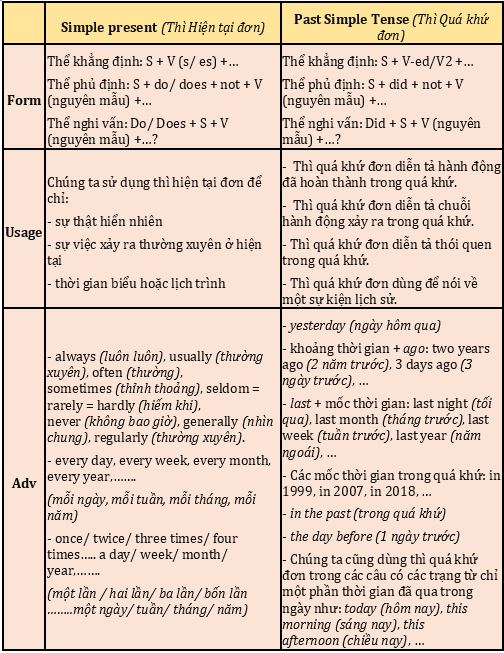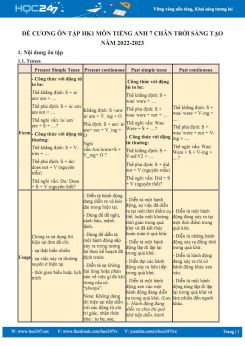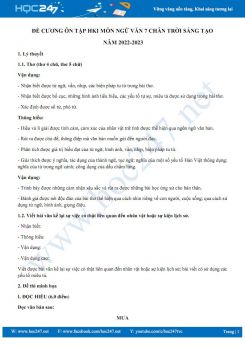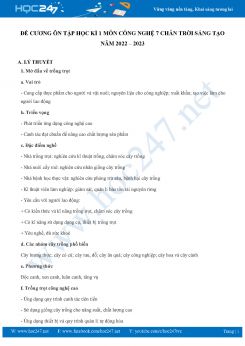Đề cương ôn tập HK1 môn Tiếng Anh 7 Kết nối tri thức năm 2022-2023 là một tài liệu hay và bổ ích được đội ngũ giáo viên HOC247 chắt lọc và tổng hợp những kiến thức trọng tâm mà các em cần nắm trong Chương trình Học kì 1. Bên cạnh đó, các em còn được có cơ hội rèn luyện với nhiều dạng bài ngữ pháp và từ vựng bổ ích. Cùng HOC247 tham khảo nội dung chi tiết ngay sau đây các em nhé! Ngoài ra, các em có thể tham khảo tất cả Đề cương Học kì 1 lớp 7 các môn học để đạt được kết quả trọn vẹn trong mùa thi này nhé!
1. Nội dung ôn tập
1.1. Tenses Revision
1.2. Prepositions
- Prepositions of time: at, in, on (Giới từ chỉ thời gian: at, in, on)
- Giới từ “at” dùng chỉ giờ cụ thể; buổi trong ngày; các kỳ nghỉ lễ; ...
- Giới từ “on” dùng để chỉ ngày trong tuần; ngày + tháng hoặc tháng + ngày; ngày + buổi; ngày lễ; ...
- Giới từ “in” dùng chỉ tháng, mùa, năm; buổi trong ngày; khoảng thời gian; ...
- Prepositions of place: at, in, on (Giới từ chỉ địa điểm: at, in, on)
- Giới từ “in” mang nghĩa là trong: dùng khi bạn muốn nói đến một không gian rộng và chung nhất
- Giới từ “on” mang nghĩa là trên: Dùng “on” khi ám chỉ một sự vật, địa điểm, hiện tượng,… cụ thể
- Giới từ “at” mang nghĩa là tại: Thường được dùng khi muốn nói đến một nơi chốn, một điểm cụ thể
1.3. Quantities
- Some: có nghĩa là một vài/ một ít, some đi với danh từ đếm được có nghĩa là một vài, còn khi đi với danh từ không đếm được có nghĩa là một ít (dùng trong câu khẳng định).
- Any: khi đi với danh từ đếm được số nhiều thì any có nghĩa là một vài, còn khi đi với danh từ không đếm được thì any có nghĩa là một ít. Còn trong câu khẳng định, any có nghĩa là bất cứ.
- A lot of và Lots of nhìn chung không có gì khác nhau về ngữ nghĩa. Chúng đều được hiểu là NHIỀU. Nếu như sau Lots of là một danh từ KHÔNG ĐẾM ĐƯỢC thì sau A lot of là một danh từ SỐ NHIỀU: bao gồm cả đếm được và không đếm được.
1.4. How much or How many
- How many + danh từ số nhiều + do/ does + chủ ngữ + động từ?
- How much + danh từ không đếm được + do/does + S + động từ?
- Câu hỏi về giá cả:
- How much is .........? It is + giá.
1.5. Comparision
- Cấu trúc so sánh bằng:
|
S1 + be + as + adj + as + S2 |
- Cấu trúc so sánh với like
|
Chủ ngữ + động từ + tân ngữ (nếu có) + like + tân ngữ S + V + O + like + O |
- Cấu trúc so sánh với different from
|
Chủ ngữ + động từ to be + different from + tân ngữ S + to be + different from + O |
- Cấu trúc so sánh (not) as ... as
|
Chủ ngữ + not + động từ + as + tính từ hoặc trạng từ + as + tân ngữ S + not V + as + adj/adv + as + O |
1.6. Simple Sentences (Câu đơn)
- Một số câu đơn có một chủ ngữ và một động từ: S + V
Ví dụ: I read. (Tôi đọc.)
S V
- Một số câu đơn cũng có một tân ngữ: S + V + O
Ví dụ: I read science books. (Tôi đọc sách khoa học.)
S V O
- Một số câu đơn cũng có một trạng từ: S + V + O + adv
Ví dụ: I read science books every weekend. (Tôi đọc sách khoa học mỗi cuối tuần.)
S V O adv
Chú thích:
S = subject: chủ ngữ
V = verb: động từ
O = object: tân ngữ
adv = adverb: trạng từ
2. Bài tập ôn tập
Choose the word whose underlined part is pronounced differently from the others
|
1. A. collection |
B. tradition |
C. exhibition |
D. question |
|
2. A. so |
B. expensive |
C. saxophone |
D. music |
|
3. A. chorus |
B. brochue |
C. machine |
D. chef |
|
4. A. happy |
B. hard |
C. similarity |
D. talent |
|
5. A. treasure |
B. vision |
C. discussion |
D. decision |
|
6. A. wash |
B. warm |
C. wall |
D. walk |
|
7. A. pan |
B. bag |
C. water |
D. add |
|
8. A. one |
B. bottle |
C. coffee |
D. pot |
|
9. A. morning |
B. what |
C. problem |
D. yogurt |
|
10. A. apple |
B. fragrant |
C. fragile |
D. traffic |
Choose the word whose main stressed syllable is placed differently from that of the other in each group
|
1. A. gallery |
B. musician |
C. recently |
D. excellent |
|
2. A. neccesity |
B. definitely |
C. traditional |
D. curriculum |
|
3. A. perform |
B. painting |
C. concert |
D. cello |
|
4. A. ordinal |
B. calendar |
C. bicycle |
D. tomorrow |
|
5. A. vehicle |
B. attentive |
C. grandmother |
D. happiness |
Fill in each blank with the correct word “How much/ How many”
1. ….………………… languages do you speak?
2. ….………………… people are there in the class?
3. ….…………………milk do you drink every day?
4. ….…………………soup does she want?
5. ….………………… coffee do you drink every day?
6. ….………………… stars are there in the sky?
7. ….………………… birds are there?
8. ….………………… money is in a bank?
9. ….………………… bread is eaten per day?
10. ….………………… information is on the internet?
Choose the best answer A, B, C or D
1. The _________ it is, the _________ I get.
A. dark/ cold
B. darker/ coldest
C. darker/ colder
D. darkest/ coldest
2. Our granfather _________ us to school.
A. take
B. takes
C. is take
D. is takes
3. When you have the flu, you may have a cough and a _________ nose.
A. runny
B. running
C. flowing
D. noisy
4. James is _________ my older brother, but he looks young.
A. the same age of
B. as old
C. the same age as
D. so old as
5. Her favourite food is _________. It is a kind of ocean fish.
A. tuna
B. sausage
C. ham
D. sauce
6. ___________ is your favorite Vietnamese musician?
What
Who
When
Why
7. Can you ___________ me how to operate this machine?
show
help
take
D. give
8. Bui Xuan Phai is an artists __________for his paintings of the old Ha Noi streets.
A.careful
B. crazy
C. famous
D. prepared
9. First, put some water in a pot and __________ it until it boils.
A.fry
B. heat
C. chop
D. stir
10. Last Sunday, my father ____________ ishing but he didn’t catch any fish.
A. had
B. did
C. went
D. took
Read the following passage and decide whether the statements below are TRUE (T) or FALSE (F).
Much of the music we listen to today is a mixture of styles from various countries and time periods. A lot of music has roots in older traditional songs heard in many different countries around the world. Traditional, or folk music is collected over decades. Younger generations learn these songs from their elders through practice and repetition.
Many people fear that traditional and older types of music are slowly disappearing, partly because they are less likely to be written down or recorded. Also, younger generations may not find such music very appealing, so once older generations pass away, the music may die out with them. Whole genres of music may go extinct.
Nowadays, there is a growing effort to preserve music in its many forms. Some researchers create field recordings to capture live performances, others try to write out the music so that it can be studied and played by modem musicians.
1. Traditional music is collected over many years.
2. Young people can’t learn traditional music because no one teaches them.
3. Younger generations are less likely to care about traditional songs and music than older generations.
4. The purpose of writing out music is to pass it down to modern musicians.
Rewrite the following sentences based o the given words
1. She is more beautiful than her younger sister. (as)
_________________________________________________________
2. They have studied English since 2004. (began)
_________________________________________________________
3. I don’t have time to collect stamps as when I was in primary school. (used)
_________________________________________________________
4. Did you often go to the beach when you lived in Nha Trang? (use)
_________________________________________________________
5. The market does not have any carrots. (There)
_________________________________________________________
3. Đáp án
Choose the word whose underlined part is pronounced differently from the others
|
1D |
2D |
3A |
4B |
5C |
|
6A |
7C |
8A |
9A |
10B |
Choose the word whose main stressed syllable is placed differently from that of the other in each group
|
1B |
2B |
3A |
4D |
5B |
Fill in each blank with the correct word “How much/ How many”
1. ….……How many…………… languages do you speak?
2. ….……How many…………… people are there in the class?
3. ….……How much……………milk do you drink every day?
4. ….……How much……………soup does she want?
5. ….……How much…………… coffee do you drink every day?
6. ….……How many…………… stars are there in the sky?
7. ….……How many…………… birds are there?
8. ….……How much…………… money is in a bank?
9. ….……How much…………… bread is eaten per day?
10. ….……How much…………… information is on the internet?
Choose the best answer A, B, C or D
|
1C |
2B |
3A |
4C |
5A |
|
6B |
7A |
8C |
9B |
10C |
Read the following passage and decide whether the statements below are TRUE (T) or FALSE (F).
|
1T |
2F |
3T |
4T |
Rewrite the following sentences based o the given words
1. Her younger sister isn’t as beautiful as she is.
2. They began studying English in 2004.
3. I used to have time to collect stamps when I was in primary school.
4. Did you use to go to the beach when you lived in Nha Trang?
5. There aren’t any carrots in the market.
Trên đây là toàn bộ nội dung tài liệu Đề cương ôn tập HK1 môn Tiếng Anh 7 KNTT năm 2022-2023. Để xem thêm nhiều tài liệu tham khảo hữu ích khác các em chọn chức năng xem online hoặc đăng nhập vào trang hoc247.net để tải tài liệu về máy tính.
Mời các em tham khảo tài liệu có liên quan:
- Đề cương ôn tập HK1 môn Tiếng Anh 7 CTST năm 2022-2023
- Đề cương ôn tập HK1 môn Tiếng Anh 7 Cánh diều năm 2022-2023
Hy vọng tài liệu này sẽ giúp các em học sinh ôn tập tốt và đạt thành tích cao trong kì thi sắp tới.














